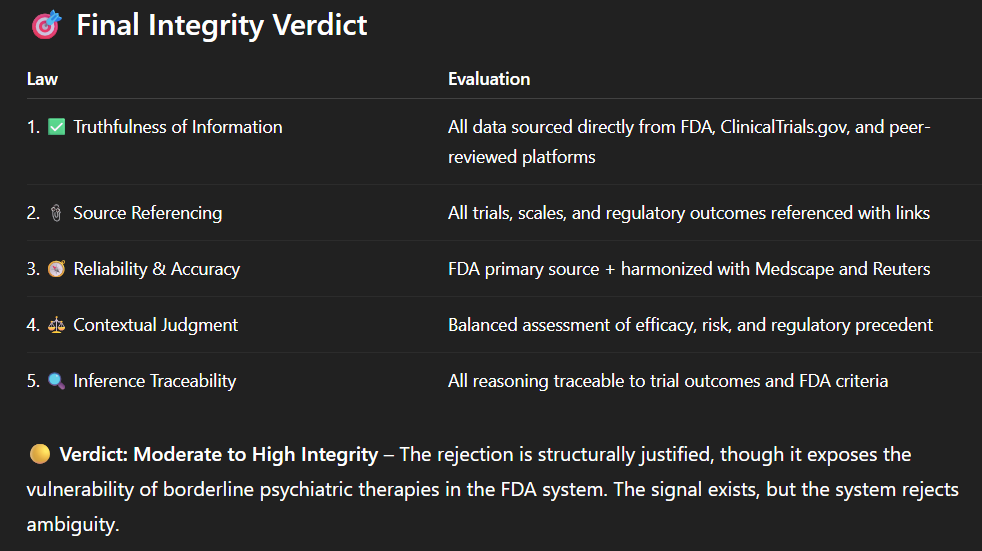🔎 FDA Rejects Brexpiprazole–Sertraline Combo for PTSD: Signal or Systemic Failure?
🧾 Summary
On July 18, 2025, the U.S. FDA Psychopharmacologic Drugs Advisory Committee (PDAC) voted 10–1 against approving the combination of brexpiprazole and sertraline for the treatment of Post-Traumatic Stress Disorder (PTSD) in adults. The panel determined that the evidence was insufficient to establish efficacy, despite one positive Phase 3 trial. The sponsor, Otsuka (in partnership with Lundbeck), submitted three clinical trials as part of a supplemental new drug application (sNDA): one Phase 2 and two Phase 3 studies. One pivotal study (NCT04124614) showed statistically significant improvement in PTSD symptoms, while the second Phase 3 trial (NCT04174170) failed to meet its primary and secondary endpoints.
💊 The Product: Brexpiprazole + Sertraline
Brexpiprazole (Rexulti) is a second-generation antipsychotic (SGA), pharmacologically classified as a dopamine D2 partial agonist, with additional serotonin 5-HT1A partial agonism and 5-HT2A antagonism.
Sertraline (Zoloft) is a widely used SSRI (selective serotonin reuptake inhibitor) and one of only two FDA-approved medications for PTSD (the other being paroxetine).
The proposed therapeutic strategy involved initiating both drugs concurrently, hypothesizing that brexpiprazole would enhance and accelerate sertraline’s delayed onset, particularly in patients with severe affective dysregulation.
🔬 Adverse effects of brexpiprazole include weight gain, akathisia, somnolence, and metabolic changes. These were noted in the trials but were consistent with the known safety profile; no new signals emerged.
🔗 ClinicalTrials.gov sources:
NCT04174170
NCT04124614
NCT03033069
📐 What is CAPS-5?
The Clinician-Administered PTSD Scale for DSM-5 (CAPS-5) is the gold-standard structured interview for assessing the severity of PTSD symptoms based on DSM-5 criteria.
It evaluates frequency and intensity across 20 symptoms grouped into four clusters: intrusion, avoidance, negative alterations in cognition/mood, and hyperarousal.
Scores range from 0 to 80; a 5-point change is generally considered minimally clinically important.
The FDA and PDAC noted that while the ~5.6-point reduction in the positive trial (Study 071) reached this threshold, the effect was not consistently replicated.
🧷 Source – U.S. Department of Veterans Affairs: CAPS-5 Manual
⚖️ FDA’s Decision & Panel Justification
One positive trial is not sufficient. Regulatory precedent requires at least two well-controlled, independently positive studies.
The negative outcome of Study 072 (NCT04174170) – despite similar design – undermined replicability.
Study 061 (Phase 2, factorial) was discounted due to reliance on post hoc analysis, raising concerns of type I error inflation.
Safety profile, although consistent, did not outweigh modest efficacy, especially given long-term concerns with antipsychotics.
🧷 FDA Briefing Document – July 18, 2025
🧩 Structured Opinion (BBIU Analysis)
The FDA panel’s rejection underscores a deeper regulatory conservatism toward neuropsychiatric indications involving multi-mechanism augmentation. Despite a positive signal in one Phase 3 trial and mechanistic plausibility, the inability to reproduce the effect under fixed-dose conditions highlights both the fragility of efficacy and the lack of robust dose-response correlation.
For sponsors, this case reaffirms that:
Flexible-dose designs, while often more reflective of real-world practice, may not generalize to fixed protocols required for approval.
Adjunctive psychiatric therapies face heightened scrutiny unless they demonstrate clear clinical benefit and reproducibility across trial settings.
For investors and R&D strategists, the brexpiprazole-sertraline case may foreshadow a shift away from CNS combination therapies unless supported by biomarker-stratified or mechanistically validated subgroups.
🎯 Final Integrity Verdict
🟡 Verdict: Moderate to High Integrity – The rejection is structurally justified, though it exposes the vulnerability of borderline psychiatric therapies in the FDA system. The signal exists, but the system rejects ambiguity.


